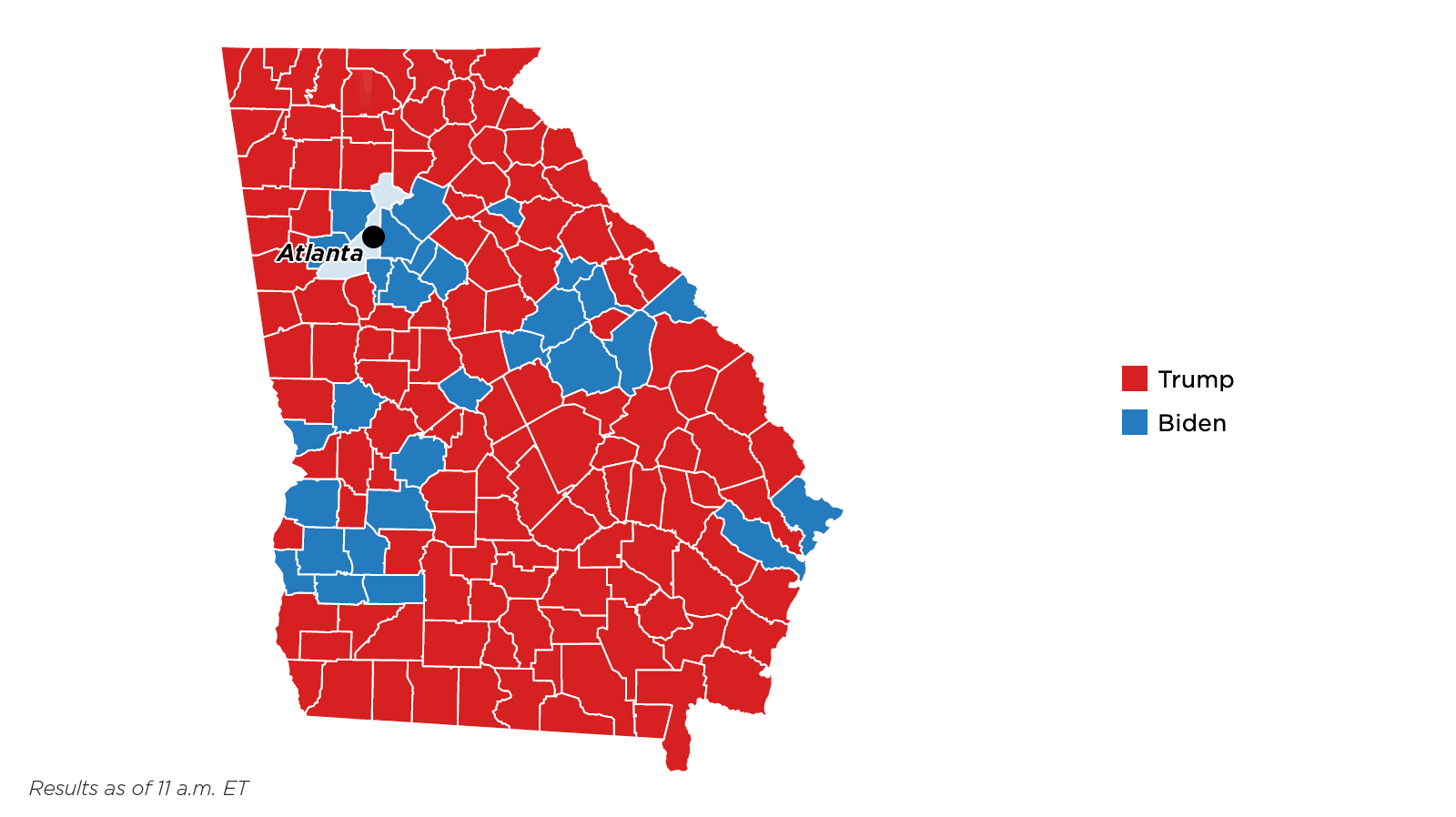By Andy Wyatt
Gwinnett County is politically fascinating. The county is solidly suburban, with its county seat, Lawrenceville, approximately 28 miles northeast of Atlanta. It is also the second-most populous county in Georgia, with 957,062 residents, according to the 2020 Census. The county is also fast-growing, especially in the metro-Atlanta area, with its population increasing by 19 percent between 2010 and 2020.
Gwinnett is incredibly diverse, tied with Alameda County, California, for the seventh-most diverse county in the U.S. It is also the most diverse county in the state of Georgia, with a diversity index of 75.1 percent. Nevertheless, just two decades ago, Gwinnett was not nearly as diverse as it is today. In 2000, the county was mostly White, at 67 percent of the population. 13 percent of residents were Black, 11 percent Hispanic, and 7 percent Asian. Since then, the county has rapidly diversified, and today, the county is overwhelmingly majority-minority, with a bare White plurality. Thirty-two percent of residents are White, 31 percent Black, 22 percent Hispanic, and 14 percent Asian.
Between 1980 and 2012, the county voted for the Republican presidential candidate every year. In 2000, Republicans had a firm grip on county-level politics, voting for George W. Bush by a nearly 2-1 margin, not sending a single Democrat in any of the districts within its boundaries to the General Assembly, and not electing a single Democrat to county-wide office or the county commission.
However, in 2016, Hillary Clinton, the Democratic nominee, carried Gwinnett in an election-night stunner, even as she lost Georgia overall. Clinton was the first Democratic presidential candidate to carry the county since native-Georgian Jimmy Carter ran in 1976. The county has moved to solid Democratic turf, voting for Democrats up and down the ballot in 2018 and onward. Today’s political landscape is almost the opposite of 2000, with Democrats controlling all of the county-wide political offices, four of the five seats on the commission, and electing many more Democrats to the General Assembly than Republicans.
Aside from realignment, Gwinnett has also been the center of recent political controversies. In 2018, the U.S. House race for District 7, which at the time included most of the county, was the closest in the nation. After a recount, incumbent Republican Congressman Rob Woodall won by a meager 419 votes. The close election result added to political conflict in the county after thousands of absentee and provisional ballots were not initially counted, two-thirds of which were cast by minority voters.
Gwinnett was also the center of a redistricting fight in 2020. In the decennial process, the Republican-led General Assembly redrew Gwinnett’s county commission districts, ignoring the commission’s proposed map. Instead, the state legislature created a district in the northern part of the county that is more Republican and where more white voters reside. Democrats criticized the state’s map, which was implemented, for packing voters of color into the three other commission districts. Republicans defended that the district represented more rural stretches of the county.
The following article is part of a series of articles analyzing Gwinnett’s political realignment that began in 2016. This article examines federal-level election returns in Gwinnett since 2000. Later installments of this series will address state and local races, partisan change, and the factors driving the county’s realignment.
Presidential Elections
Twenty-first-century presidential election results in Gwinnett show how much the county has changed politically. Between 2000 and 2020, the Democratic presidential candidates increased their vote percentage by 26 percentage points. The results also present three phases of realignment in Gwinnett: pre-Obama era Republican dominance, increasing competition during the Obama era but still a Republican lean, and post-Obama era Democratic ascendancy.
In the pre-Obama era elections, 2000 and 2004, the Democratic candidates Al Gore and John Kerry each received 34 percent of the vote. Nonetheless, support for the party surged by 11 percentage points from 2004 to 2008, when Barack Obama garnered 45 percent of the vote. Obama again secured 45 percent of the vote in the 2012 election.
In 2016, in a surprise to observers statewide, Clinton flipped the county to the Democratic Party, taking 53 percent of the vote and building on Obama’s vote percentage by eight percentage points. In 2020, President Joe Biden converted Gwinnett into solid Democratic territory by expanding on Clinton’s victory by six percentage points to win a landslide 59 percent of the vote. Strong margins in the county undoubtedly contributed to Biden’s narrow victory in Georgia that year.
Observing raw vote trends in Presidential elections in Gwinnett demonstrates key changes in voting in the county since 2000. Since 2004, the raw vote total for Republican candidates has remained nearly stagnant, averaging 158,500 votes. In his re-election campaign, former President Donald Trump only managed 6,000 more votes than when former President George W. Bush was in the same position in 2004.
Republican stagnation contrasts sharply with the Democratic raw vote total, which increased fourfold between 2000 and 2020. In 2000 and 2004, Gore and Kerry fell below the 100,000 vote threshold, at 61,000 and 82,000, respectively.
As the two-party vote results demonstrated, Democratic support in Gwinnett surged in 2008. Compared to Kerry, Obama received 47,317 more votes, increasing the raw Democratic vote by a massive 58 percent. In 2012, Obama received only 3,000 more votes than he did in 2008.
The raw Democratic vote substantially increased again in 2016, with Clinton obtaining 34,000 more votes than in Obama’s 2012 performance, for a 26 percent increase. Biden
turned out 77,000 more voters than Clinton, a 46 percent increase from 2016. This occurred as turnout notably increased nationwide in 2020.
U.S. Senate Elections
Twenty-first-century regular U.S. Senate election results in Gwinnett also reveal the extent to which the county has realigned. Between 2002 and 2022, the Democratic Senate candidates increased their vote percentage by 26 percent. Furthermore, starting in 2010, Democratic candidates have boosted the party’s share of the two-party vote from the previous election.
In 2000, the Democratic candidate, incumbent Senator Zell Miller, received 51 percent of the two-party vote in the county, outperforming Gore by 17 percentage points in a sign of split-ticket voting during that election. However, support for the party plunged in 2002 when incumbent Senator Max Cleland ran for re-election and obtained 35 percent of the two-party vote. Likewise, in 2004, Denise Majette received 33 percent. Compared to 2000, split ticketing declined significantly as Majette only underperformed Kerry by one percentage point. Another Democratic candidate for the Senate did not receive a majority of the two-party vote again until Jon Ossoff ran in the 2020 regular Senate election.
In 2008, Obama’s coattails followed candidate Jim Martin as he, like Majette, underperformed the presidential candidate by only one percentage point to receive 45 percent of the county’s vote. Martin improved upon Majette as Democratic support increased by 12 percentage points, out-doing the increase in Democratic presidential support between 2004 and 2008.
Starting in 2014 with Michelle Nunn, Democratic candidates, on average, increased the percentage of the Democratic vote in Gwinnett from the previous by approximately five percentage points. Nunn increased Michael Thurmond’s, the 2010 candidate, share of the two-party vote by nine percentage points.
While Clinton carried Gwinnett with 53 percent of the two-party vote, her coattails did not wholly show through in a signal of down-ballot lag. Jim Barksdale, a relatively unknown businessman to Georgia voters and first-time candidate, ran against incumbent Senator Johnny Isakson, who was popular among Georgia voters. Barksdale achieved 48 percent of the county’s two-party vote, a five percentage point drop off compared to Clinton and demonstration of the 2016 election as a dealignment election for the county rather than a complete realignment.
Nonetheless, in 2020, Jon Ossoff became the first Democratic candidate since Miller to win the county in a Senate contest, romping his competitor, incumbent David Perdue, with 58 percent of the two-party vote. Ossoff bettered Barksdale’s percentage by a whopping ten percentage points. In 2022, incumbent Senator Raphael Warnock slightly surpassed Ossoff, winning 60 percent of the two-party vote to become the first Democratic candidate running for any position to cross the 60 percent line in Gwinnett in the twenty-first century.
Congressional Elections
Of all federal races occurring in Gwinnett, Democrats have faced the most difficulty in congressional elections, mainly due to the party not fielding candidates in every district in the county in the years 2000, 2002, 2004, 2008, 2012, 2014, and 2016. Nonetheless, the Democratic Party has demonstrated the most improvement in congressional elections of any other type of contest. Between 2000 and 2022, the Democratic party massively increased its two-party vote percentage by 43 percentage points.
Congressional elections in the county validate the Democratic Party’s struggle to be competitive in the county before 2008, with the party bottoming out at 14 percent of the two-party vote in 2000 because it did not run a candidate in the District 11, which included more of the county’s population than the two other districts in the county: the Districts 4 and 6.
In 2002, the party increased its proportion of the two-party vote by 11 percentage points for 25 percent. Continuing its struggles, the party then regressed in 2004 to 15 percent of the vote but enormously improved to 32 percent in 2006.
Furthermore, the Democratic Party’s percentage of the two-party vote in the county’s congressional elections did not cross the 40-percent line until 2008, when Obama’s coattails carried down the ballot, with U.S. House candidates netting 44 percent of the two-party vote. After this election, Democratic candidates in the county averaged 43 percent of the vote between 2010 and 2016, with their best performance in 2014 when they pulled 48 percent of the two-party vote because the Republican Party did not have a standing candidate in the District 4.
In 2016, again exemplifying split-ticket voting with votes for Clinton at the top of the ticket and Republicans down-ballot, Democratic candidates collectively captured 45 percent of the two-party vote in U.S. House races. However, no candidate stood for the party in District 10, including the smallest electorate of Gwinnett residents.
In 2018, the party achieved a majority of the two-party vote in congressional contests in Gwinnett for the first time in the twenty-first century, with 56 percent of the vote and an 11 percentage point increase from 2016. Democrats reached this feat by winning 55 percent of the vote in District 7, which included most of the county’s population. In that race, first-time candidate Carolyn Bourdeaux ran vigorously against Republican incumbent Rob Woodall. After a recount, Bourdeaux came just 419 votes short of flipping the district, which covered a more Republican area in Forsyth County as well.
In 2020, the party attained its apex of the two-party vote in congressional elections in the county with 58 percent of the vote and Biden’s coattails almost entirely flowing down-ballot. That election, Bourdeaux, running for the second time, beat a MAGA conservative, Rich McCormick, outright in District 7. She landed 58 percent of the vote in the Gwinnett portion of the district. The party also received 57 percent of the two-party vote in the 2022 midterms, with the Democratic Representative Lucy McBath winning District 7 after representing the Sixth District, including the north Atlanta suburbs, for four years.
Conclusion
Although Gwinnett was Republican-leaning territory through 2014, the county has solidly realigned to the Democratic Party. After the 2000 U.S. Special Senate election that Zell Miller ran in, the county did not vote for another Democrat until Hillary Clinton’s bid for the presidency in 2016. However, that cycle was more of a dealignment election for the county it voted for Republicans in down-ballot races. In 2018, the county completely realigned to the Democratic Party, giving Democratic candidates a substantial majority vote to U.S. House candidate Carolyn Bourdeaux. The county became even more Democratic in 2020, with Joe Biden leading the way, and the county again chose Democrats in the 2022 midterm elections.


